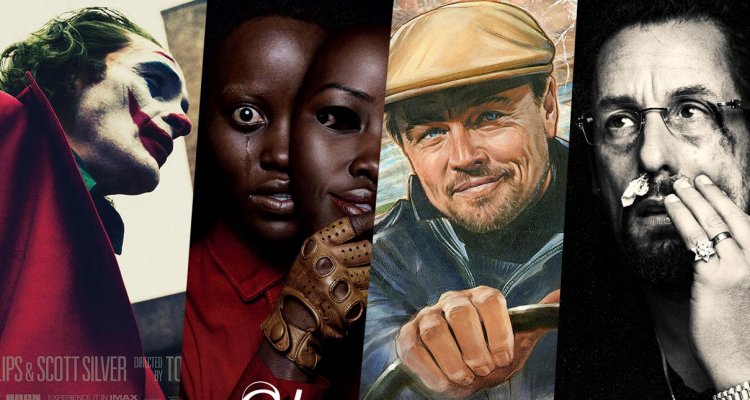10.“Transit”
Nothing lasts forever, but what happens when even the things that supposedly define your essence begin to slip away? In Christian Petzold’s ethereal story of souls in movement, a man adopts the identity of another. It’s an act of survival, but when love intervenes, it all becomes a bit hazier. Franz Rogowski leads this as the man in question, Georg, and it’s a smart move from The Boland Design Company to frame him with power, in the center of the frame – but not quite in control. The viewer only gets half of his face, and his back merely reflects the window pane, itself showing Marie (Paula Beer, an esteemed regular collaborator of Petzold’s) waiting, looking. There are many layers here – the perspective of both people, but also the clear glass interfering. It keeps people out, obscures the visible truth, confuses feeling with clinical coldness. But, everything is temporary – the promise of a shift, of a meeting, looms large. – EK

9. “The Souvenir”
“The Souvenir” paints a picture of refracted identity, of love that keeps secrets and self-worth that constantly waters itself down. Joanna Hogg revisits her memories as an ambitious film student, and writes in a toxic relationship with an older man. In the film, she is Julie (Honor Swinton-Byrne, daughter of Tilda, in he first ever role), and he is Anthony (Tom Burke making a triumphant return to the spotlight). The poster remembers the couple’s fleeting vacation to Venice – see the pearls around her neck and her wrist, his double-cuff shirt underneath the dinner jacket. Her eyes are only visible in the reflection, while his mouth suggests another jab, another disappointment mid-conversation. Focus is played with so carefully – lights behind them are creamy, and the shape that looks back at Anthony has no line of eyesight. Are they leaning on water, or on a structure? How safe is this? It’s a slippery, sophisticated design, one that asks more questions than it answers – making it a perfect counterpart to the film’s mysterious, overwhelming beauty. – EK

8. “Uncut Gems”
There is so much chaos and anxiety in the Safdies’ latest thriller, “Uncut Gems.” Their New York picture throws Adam Sandler into the wolves as Howard Ratner, a Jewish jeweler in the diamond district who gets embroiled in a haywire coup in the name of greed and ambition. It’s a smart move, then, to capitalize on the all-encompassing potential for disaster of their leading man. No landscape, no antagonists. Just a man, Sandler, looking out at what he has done – or what he regrets not having thought of. There’s gold on his fingers and a heavy watch on his wrist. But what’s more telling? The sheen on his digits or the blood on his face? The poster shows restraint, it teases the unknowing bystander. Take a chance on “Uncut Gems” and that darkness could swallow you whole. – EK

7. “The Last Black Man in San Francisco”
The streets of San Francisco are slanted, making them perfect to skate down. Jimmie Fails knows this, and it’s the only way he gets from one world to another in “The Last Black Man in San Francisco.” Joe Talbot’s feature debut takes stock of the idea of both heritage and evolution, framing Fails, his real-life childhood best friend, as he comes to terms with the city he loves so much that he is often forced to hate. Akiko Stehrenberger captures this, painting Fails alone on one of the city’s many streets like a storybook character. The film does often feel like a fairytale, but a skewed one, one that feels more credible. Stehrenberger’s other design sees Fails and behind him his friend Montgomery (astoundingly acted by Jonathan Majors). Both men look up – at the sky that belongs to us all, or the city that used to be theirs? If you look closer, Fails’ shirt (that he wears almost from start to finish in the film) shelters the faint drawings of the city’s other locals – further showing endless layers of love to this very personal homecoming portrait. – EK

6. “Portrait of a Lady on Fire”
The first poster for Celine Sciamma’s stunning sapphic romance was already a thing of beauty, framing Adele Haenel with a scorched dress, demanding the viewer’s attention for her story. But Akiko Stehrenberger has arrived: strokes of orange, yellow and red paint wave and curve, with thick layers of incandescent colors making a magnificent trompe-l’oeil design in the fewest movements conceivable. It could be the flames of the hearth; it could be the dress of the painter, or the muse. But if you readjust your eyes, zoom in and breathe out on the potential, they’re right there. The silhouettes of two profiles, two faces leaning in to kiss. Her lips on the right, only slightly higher than hers on the left. These perspectives play with each other and let the viewer see what they need, too. It’s stunningly simple, heartbreakingly effective. – EK


